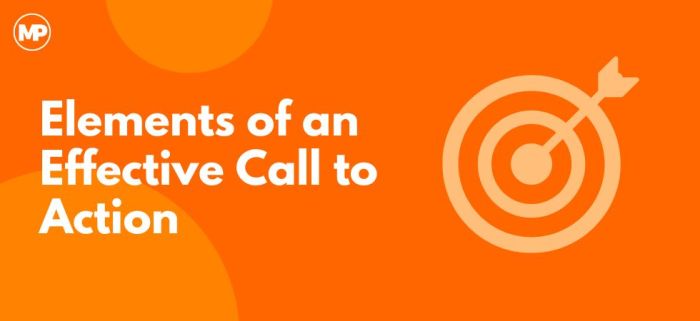Crafting compelling call-to-actions (CTAs) is crucial for online success. A well-designed CTA seamlessly guides users towards desired actions, whether it’s making a purchase, signing up for a newsletter, or downloading a resource. This guide delves into the art and science of creating CTAs that not only look good but also convert effectively, exploring design principles, persuasive copywriting techniques, and strategic placement strategies to maximize impact.
From understanding color psychology and visual hierarchy to A/B testing different copy variations and leveraging the power of urgency, we’ll cover everything you need to know to design CTAs that truly resonate with your audience and drive results. We’ll examine practical examples and provide actionable steps to help you transform your CTAs from simple buttons into powerful conversion engines.
Understanding Call-to-Action (CTA) Design Principles
Crafting effective call-to-actions (CTAs) is crucial for guiding users towards desired actions on a website or application. A well-designed CTA seamlessly integrates with the overall design, prompting users to engage with your content or make a purchase. Understanding key design principles ensures your CTAs are not only visually appealing but also highly effective.
Compelling CTA Button Design
A compelling CTA button relies on a combination of color contrast and clear, concise language. High contrast ensures the button stands out from its background, immediately drawing the user’s attention. Effective color palettes often employ complementary or analogous colors, creating a visually pleasing and impactful effect. For instance, a bright green button on a dark blue background provides excellent contrast and is often associated with growth and action. Alternatively, a vibrant orange button against a deep teal background creates a similar level of contrast and evokes feelings of energy and excitement. Conversely, a muted grey button on a white background will likely be overlooked. The language used on the button should be short, action-oriented, and directly reflect the desired action. Instead of “Learn more about our products,” a more effective option might be “Shop Now” or “View Products.”
Whitespace and Visual Hierarchy in CTA Placement
Strategic use of whitespace and visual hierarchy is essential for guiding the user’s eye towards the CTA. Whitespace provides breathing room, preventing the design from feeling cluttered and overwhelming. Visual hierarchy, achieved through size, color, and placement, emphasizes the CTA, making it the focal point. Consider these examples:
| Before | After |
|---|---|
| Imagine a cluttered webpage with many elements of equal size and color. The CTA button is small and lost among other elements. | The same webpage, but now the CTA button is larger, uses a contrasting color, and is positioned prominently, often at the end of a section or page. Surrounding elements are subtly de-emphasized with appropriate spacing. |
CTA Button Shapes and Sizes
The shape and size of a CTA button can subtly influence user engagement. Different shapes evoke different psychological responses.
- Rectangular Buttons: These are the most common and generally considered versatile. They are easily recognizable and integrate well with most designs.
- Square Buttons: These offer a sense of stability and balance. They are suitable for calls to action that require a sense of trust or reliability.
- Rounded Rectangular Buttons: These provide a softer, more approachable feel, making them a good choice for friendly and inviting calls to action.
- Circular Buttons: While less common for primary CTAs, they can be used effectively for less prominent actions. Their compact size makes them suitable for smaller screens.
- Size: Larger buttons are generally more noticeable and easier to click, particularly on mobile devices. However, excessively large buttons can feel overwhelming.
Effectiveness of Different Verb Choices in CTAs
The verb used in a CTA significantly impacts its effectiveness. Strong action verbs encourage immediate engagement.
- “Learn More“: This is a good option when providing additional information is the primary goal. It’s less direct than other options.
- “Get Started“: This is effective for initiating a process or trial. It implies ease of use and encourages immediate participation.
- “Download Now“: This is highly effective when offering downloadable content. The immediacy of “Now” creates a sense of urgency.
- “Shop Now“: This is ideal for e-commerce websites, directly prompting users to make a purchase.
- “Sign Up“: Used for subscriptions or account creation, this verb is clear and concise.
Crafting Persuasive CTA Copy

Crafting compelling call-to-action (CTA) copy is crucial for driving conversions. Effective CTA copy goes beyond simply telling users what to do; it persuades them to take action by highlighting the benefits and addressing their needs. The right words can significantly impact click-through rates and ultimately, the success of your marketing campaign.
Benefit-Driven CTA Copy Examples
Let’s illustrate the power of benefit-driven language with five different CTA copy options for a hypothetical product launch – a new noise-canceling headphone called “Hush Headphones.” Each option focuses on a distinct benefit:
- Option 1 (Focus on Peace): “Escape the Noise. Find Your Focus. Get Hush Headphones Now.” This option highlights the core benefit of noise cancellation – peace and quiet.
- Option 2 (Focus on Productivity): “Unleash Your Productivity. Experience Uninterrupted Focus with Hush Headphones.” This CTA appeals to users seeking improved work efficiency.
- Option 3 (Focus on Relaxation): “Relax and Unwind. Discover the Bliss of Silence with Hush Headphones.” This targets users prioritizing relaxation and stress reduction.
- Option 4 (Focus on Premium Quality): “Experience Superior Sound Quality. Order Your Hush Headphones Today.” This option emphasizes the product’s high-quality audio.
- Option 5 (Focus on Limited Availability): “Limited Stock Available. Secure Your Hush Headphones Before They’re Gone!” This leverages scarcity to create urgency.
Impact of Strong Action Verbs and Power Words
Using strong action verbs and power words significantly boosts CTA effectiveness. Strong verbs create a sense of urgency and directness, while power words evoke emotion and enhance the message’s impact.
Examples include:
- Strong Verbs: Instead of “Learn more,” use “Discover,” “Unlock,” “Unleash,” or “Experience.”
- Power Words: Words like “revolutionary,” “exclusive,” “transformative,” “ultimate,” “guaranteed,” and “instant” can add weight and excitement to your message. For example, “Transform your listening experience with Hush Headphones” is more compelling than “Get new headphones.”
Choosing the right words depends heavily on your target audience and the specific product or service being promoted. A/B testing different word choices helps determine what resonates best.
A/B Testing CTA Copy Variations
A/B testing allows you to systematically compare different CTA variations and measure their impact on conversion rates. This iterative process helps optimize your CTA for maximum effectiveness. Below is a sample A/B test plan:
| CTA Version | Metrics Tracked | Results (Hypothetical) | Notes |
|---|---|---|---|
| “Get Hush Headphones Now” | Click-Through Rate (CTR), Conversion Rate | CTR: 2%, Conversion Rate: 0.5% | Baseline version |
| “Experience Uninterrupted Focus” | Click-Through Rate (CTR), Conversion Rate | CTR: 2.5%, Conversion Rate: 0.7% | Benefit-driven language improved performance |
| “Discover the Bliss of Silence” | Click-Through Rate (CTR), Conversion Rate | CTR: 2.2%, Conversion Rate: 0.6% | Slightly less effective than version 2 |
| “Unlock Superior Sound Quality” | Click-Through Rate (CTR), Conversion Rate | CTR: 2.8%, Conversion Rate: 0.8% | Strong verb and benefit combination performed best |
Urgency and Scarcity-Based CTA Design
A CTA emphasizing urgency and scarcity leverages psychological principles to motivate immediate action. The fear of missing out (FOMO) and the principle of scarcity – the idea that limited availability increases perceived value – are powerful motivators.
For example: “Only 50 left in stock! Order your Hush Headphones now before they’re gone!” This CTA combines a clear quantity limitation (“Only 50 left”) with a strong call to action (“Order now”) and a warning of impending unavailability (“before they’re gone”). This approach taps into the fear of missing out and the desire to secure a limited resource, thus encouraging immediate purchase.
Optimizing CTA Placement and Context

Effective call-to-action (CTA) placement is crucial for maximizing conversions. A well-placed CTA seamlessly integrates with the user experience, guiding visitors towards the desired action without feeling intrusive or disruptive. Understanding user flow and leveraging visual cues are key elements in this optimization process.
Optimal CTA Placement on Landing Pages
The optimal placement of a CTA depends heavily on the specific landing page and its objective. However, some general principles apply. Consider the user’s journey and where they are most likely to be receptive to your call to action. Placing a CTA too early might interrupt the user’s understanding of the offer, while placing it too late risks losing their attention.
Several placement options exist, each with advantages and disadvantages:
- Above the fold (immediately visible): This prominent placement grabs immediate attention. However, it can feel intrusive if the user hasn’t yet understood the value proposition. It’s best suited for simple, high-impact offers with clear value.
- Below the fold (requires scrolling): This allows for a more gradual introduction to the offer, letting the user engage with the content before encountering the CTA. However, it risks losing users who don’t scroll down the page. It’s suitable for longer-form content where a deeper understanding of the value proposition is needed before conversion.
- Within the content (integrated placement): This approach places the CTA strategically within the text or visuals, aligning it with specific sections relevant to the offer. This can improve engagement by presenting the CTA at a moment of heightened interest. However, it requires careful planning to ensure the CTA doesn’t disrupt the flow of the content.
- At the end of the page (summary placement): This position summarizes the offer and encourages a final conversion attempt. It’s effective for longer-form content or pages with multiple sections. However, it relies on the user scrolling through the entire page.
Using Visual Cues to Guide Users Towards the CTA
Visual cues effectively draw attention to the CTA and enhance its visibility. They act as signposts, guiding users towards the desired action. Effective visual cues should be subtle yet noticeable, complementing the overall design rather than clashing with it.
Examples of effective visual cues include:
- Arrows: Clearly pointing towards the CTA button.
- Highlighting: Using contrasting colors or a subtle shadow to make the CTA stand out.
- Visual elements: Integrating the CTA with relevant images or videos to create a more engaging and contextual experience.
- Motion effects: Subtle animations or micro-interactions that draw attention to the CTA without being distracting.
Above the Fold vs. Below the Fold CTA Placement
The decision of placing a CTA above or below the fold depends on several factors:
- Content length: For shorter pages, above-the-fold placement might be more effective. Longer pages often benefit from a below-the-fold approach.
- Value proposition clarity: If the value proposition is immediately apparent, an above-the-fold CTA can work well. If more explanation is needed, a below-the-fold placement might be preferable.
- Target audience: Consider your target audience’s behavior and preferences. Some audiences might be more likely to scroll than others.
- A/B testing results: Ultimately, the best placement is determined through rigorous A/B testing, comparing conversion rates for different positions.
Mock-up of a Website Homepage with Strategically Placed CTAs
Imagine a homepage for a fictional online clothing store. The hero section features a large, high-quality image of a model wearing a new season’s outfit, with a prominent CTA button: “Shop New Arrivals” placed centrally and above the fold. This immediately captures attention and encourages browsing the latest collection.
Below the hero section, a carousel showcases different product categories (e.g., dresses, tops, jeans). Each category image includes a smaller CTA button: “Shop Now” directly beneath it, encouraging exploration of specific product lines. These are below the fold, but strategically placed to capitalize on interest generated by the visuals.
Further down, a section highlights customer testimonials, fostering trust and credibility. At the end of this section, a CTA “See More Reviews” is placed, encouraging users to learn more about customer experiences.
Finally, a section promoting a limited-time sale features a large, visually striking CTA button: “Get the Deal Now!” placed prominently at the bottom of the page, acting as a final call to action before users leave the site. This placement ensures that even if users have scrolled through everything else, they’re still presented with a compelling offer. The reasoning behind each placement focuses on optimizing the user journey and creating a smooth, engaging experience that encourages conversions at various points along the way.
Last Recap

By mastering the principles Artikeld in this guide, you’ll equip yourself to create highly effective call-to-actions that significantly improve user engagement and conversion rates. Remember, a well-designed CTA isn’t just about aesthetics; it’s about understanding user psychology, employing persuasive language, and strategically positioning your call to action within the overall user experience. Continuous testing and optimization are key to refining your CTAs and achieving peak performance. Implement these strategies and watch your conversions soar.